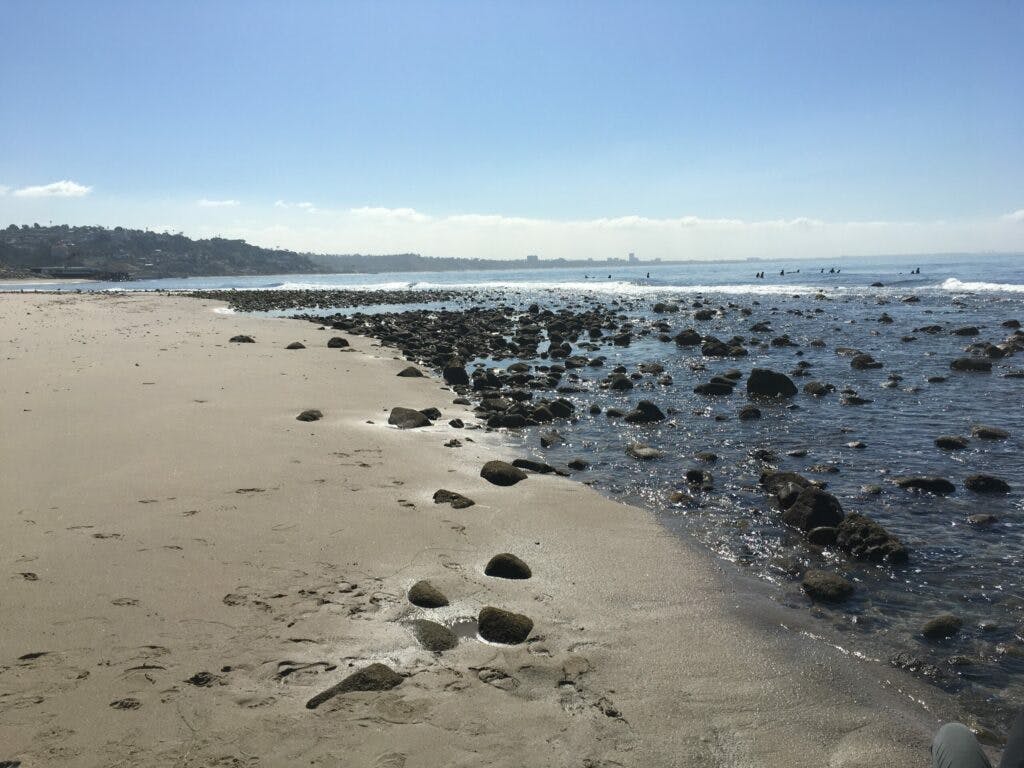- English
- Spanish
- Korean
- Filipino
- Armenian
- Chinese (Simplified)
Rocky Intertidal
Prev
Sandy Shores
Next
Pelagic
Habitat Overview
Rocky intertidal habitats are found at the interface between ocean and land. In Santa Monica Bay these habitats are primarily found along Palos Verdes Peninsula and in Malibu, with mostly sandy beaches along the coast in between.
The rocky intertidal habitat in the south end of Santa Monica Bay, off Palos Verdes tends to be composed of bedrock that is not strongly influenced by sand, although landslides have added sediment with local impacts, with warmer water. By contrast, in the north end of Santa Monica Bay off the Malibu coastline, water temperatures are usually cooler, and the rocky intertidal is composed mostly of cobble/boulder outcrops surrounded by and influenced by sand.
Physical conditions in rocky intertidal habitats are highly variable. Primary environmental factors that drive differences in species composition and biodiversity at the site level are the substrate, whether bedrock, cobble/boulder, or mixed sand-rock, and the wave regime, whether exposed or protected. Other factors include sand exposure, slope, 3-dimensional complexity, water temperature, air temperature during low tide exposure, and adjacent coastal habitat. Salinity and levels of dissolved oxygen and carbon dioxide may change during low tides.
Some of these factors, such as temperature and wave or sand exposure, vary seasonally as well as geographically. Site-to-site differences in these physical features result in expected differences in community composition. For example, a site with more wave exposure has different species and abundance patterns than a site that is more sheltered. Thus, comparing data across multiple sites requires similar physical characteristics to accurately assess trends.
Status
| Indicator | Score | Confidence |
|---|---|---|
| Habitat Extent | Moderate | |
| Habitat Vulnerability | Low, Low | |
| Structure & Ecological Disturbance | Moderate, Moderate | |
| Biological Response | Low, Low |
Per the Rocky Intertidal habitat's 2015 condition, see below for condition details.
Why Is a Healthy Rocky Intertidal Habitat Important?
Species Habitat
In Southern California, Rocky Intertidal habitats can support as many as 500 species of macroinvertebrates and seaweeds (Littler 1980), including the iconic ochre sea star Pisaster ochraceus, the ever-present acorn barnacles Chthamalus spp. and Balanus glandula, and even the federally endangered black abalone (Haliotis cracherodii). Wading birds forage in tidepools during low tides and nearshore fishes use these habitats for food and refuge at high tides.
Recreational and Educational Benefits
Rocky intertidal habitat provides a multitude of benefits to humans, such as outdoor recreation and experiential learning opportunities. In Santa Monica Bay, many rocky intertidal areas are protected as Marine Protected Areas (MPAs).
Primary Challenges
Environmental and Human Disturbances
Large-scale natural environmental disturbances, like rising sea level, temperature and ocean acidification are of regional concern, but cannot be addressed solely by local management actions.
Rocky intertidal habitats are also vulnerable to a range of human impacts. Tide-poolers can relocate organisms from the intertidal to less hospitable habitats and can inadvertently trample invertebrates and vulnerable algal species, fishermen and collectors can remove select species, and where there are storm drains, urban runoff can alter salinity, nutrient levels, water quality, and water clarity.
All of these disturbances can impact species diversity, community composition, and ecosystem functions.
2015 Habitat Condition
Read more about the rocky intertidal habitat’s conditions through our data and research published in the 2015 State of the Bay Report.
